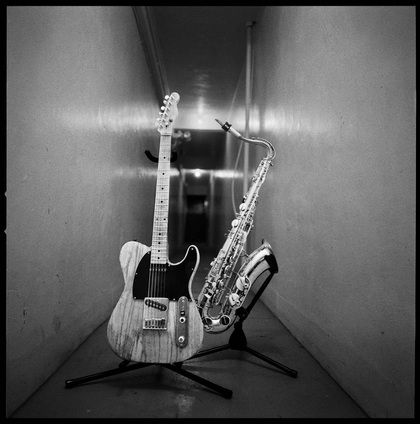It’s no secret that your average saxophone player is light-years ahead of your average guitarist when it comes to improvisation; this is mainly because your average saxophonist knows the shit out of chords, but your average guitarist doesn’t. This is slightly ironic because you can’t play chords on a saxophone, but anyway, what I’d like to do here is look at a concept that saxophone players use to improvise and apply it to our beloved instrument to see if we can’t beat them at their own game. Both guitarists and saxophonists learn and practice scales, but a saxophonist must know what notes are in the scale in order to play it. A guitarist, on the other hand, can learn a scale without knowing what notes or intervals are in it by virtue of a pattern on the fretboard. This is where we, as guitarists, screw ourselves over somewhat as we shall see…
If you ask an average guitarist to play something over an Am9 to Gm9 progression, they might play Am Pentatonic and Gm Pentatonic – both of which don’t actually feature the 9th – and the result would be okay but a little lame. A smart(er) guitarist might realize that those chords are from the F Major scale and blow over the changes with that but starting on A and G respectively, which again would sound okay if a little hit and miss. A sax player, on the other hand, would know what notes and intervals are in those chords and play something based on the chord tones rather than blow up and down a scale or two.
Sax It Up
Sax players practice improvising by practicing triads and adding in notes. If you’re playing over Am9 and Gm9, you have the following notes:
Am9 – A, C, E, G, B
Gm9 – G, Bb, D, F, A
A minor 9 chord contains the intervals 1, b3, 5, b7, 9 so our triad here is a minor one (1, b3, 5) and this will be our ‘safety net’ when improvising. What sax players do is practice with four notes, usually the triad plus another chord tone, or any other tone for that matter.
If you know the notes on the neck, locate an A Minor triad and add one of the other chord tones to it. If you’re not too sure about the notes on the neck, you’ll have to do some pre-planning and arrange them into a pattern like the one below.

Here you have all the notes from an Am9 chord in a pentatonic-ish layout. Improvise by playing the A Minor triad (A, C, E) and adding either the G (the b7) or the B (the 9) in four-note groups. If you’re relying on patterns, you’ll need to do the same for the Gm9 chord. What you could do is just move the above pattern down two frets, but it becomes somewhat unmusical because we’re relying on the middleman – the pattern – and this is the crux of it: what we should do as guitarists is cut out the middleman and go straight to the notes but for the benefit of those that are not quite there yet but want to know what this sounds like, we’ll include the patterns.
Instead of just moving the whole thing down two frets, we can place the notes from the Gm9 chord as close to the Am9 as possible.

While this might seem trickier at first, it’s a far more musical way of playing these changes because you notice that you can go from a B to a Bb (and vice versa) when the chord changes, or an E to an F, and these are the things that make you sound like you know what you’re doing when soloing; but which either go unnoticed or are harder to do when shifting the pattern down two frets.
The ideal thing to do here then is to bypass the pattern and use the notes themselves instead of creating all this extra work.
When you’re comfortable with either the two patterns, or the two sets of notes and intervals, see if you can play over the backing track below which goes from Am9 to Gm9 and warns you on-screen when the chords are changing. The four-note cells to use are as follows:
Minor triad + b7
Minor triad + 9



